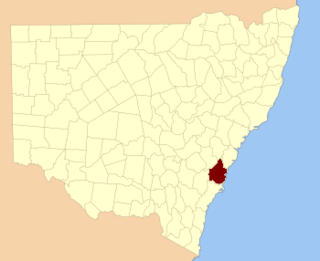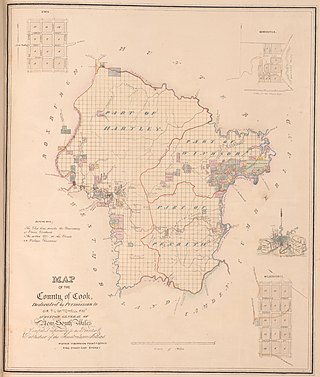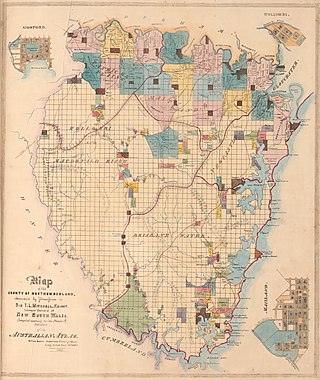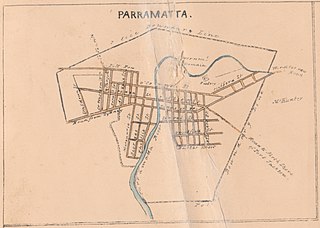
The Electoral district of Port Phillip was an electorate of the New South Wales Legislative Council before it became the separate colony of Victoria (Australia) on 1 July 1851. At the time, some members of the Council were elected and the balance were appointed by the Governor. The Town of Melbourne returned one member while the Port Phillip district, which covered the rest of what became Victoria after its separation in 1851, returned five members.

The Electoral district of Town of Melbourne was an electorate of the New South Wales Legislative Council before it became part of the Colony of Victoria on 1 July 1851.
This is a list of members of the New South Wales Legislative Council from 1843 to 1851. The 1843 Electoral Act prescribed 36 members, 24 to be elected, 6 appointed by virtue of their office and 6 nominated. The appointments and elections were for five year terms and thus occurred in 1843, and 1848. The Speaker was Alexander Macleay until 19 May 1846 and then Charles Nicholson. The parliament was dissolved on 30 June 1851 as a result of the 1851 Electoral Act which increased the number of members in the Council to 54.

The Electoral district of County of Camden was an electorate of the New South Wales Legislative Council at a time when some of its members were elected and the balance were appointed by the Governor.

The Electoral district of County of Durham was an electorate of the New South Wales Legislative Council at a time when some of its members were elected and the balance were appointed by the Governor. It was named after Durham County, which lies on the north side of the Hunter River.

The Electoral district of Counties of Gloucester, Macquarie, and Stanley and from 1851, Gloucester and Macquarie, was an electorate of the partially elected New South Wales Legislative Council, created for the first elections for the Council in 1843. The counties of Gloucester and Macquarie were the settled coastal areas north of Northumberland County, while the County of Stanley was the area surrounding Brisbane, in what became part of Queensland after its separation in 1859. Polling took place at Raymond Terrace, Port Macquarie, Dungog, Stroud, Brisbane, Ipswich and Mr Rowley's residence on the Manning River. The County of Stanley was removed from the district with the expansion of the Council in 1851 and became the districts of County of Stanley and Stanley Boroughs.
Donald McIntyre, sometimes referred to as Donald MacIntyre, was a Scottish-Australian colonial politician, who was a member of the New South Wales Legislative Council from 1848 to 1851.

The Electoral district of Counties of Cook and Westmoreland, also known as the United Midland Counties of Cook and Westmoreland, was an electorate of the New South Wales Legislative Council at a time when some of its members were elected and the balance were appointed by the Governor.
The electoral district of Cumberland Boroughs, also known as the united towns of Windsor, Richmond, Liverpool and Campbelltown, was an electorate of the New South Wales Legislative Council at a time when two thirds were elected, one sixth were official members, that is they held a government office and the balance were appointed by the Governor.
The 1843 New South Wales colonial election, the first in the colony, was held between 15 June and 3 July 1843, to elect 24 members from 18 electoral districts. Each district returned 1 member except for Port Phillip which returned 5 members while County of Cumberland, and Town of Sydney returned 2 each.
The 1848 New South Wales colonial election was held between 29 July and 2 August. No candidates were nominated for Port Phillip as a result of the campaign for independence from New South Wales, and a fresh writ was issued for an election on 3 October.
The Electoral district of Counties of Hunter, Brisbane and Bligh and from 1851, Phillip, Brisbane and Bligh, was an electorate of the partially elected New South Wales Legislative Council, created for the first elections for the Council in 1843. The electoral district included the north western counties of Hunter, Brisbane, Bligh. Polling took place in the towns of Jerrys Plains, nearby Merton, Muswellbrook, Scone, as far north as Murrurundi, Watson's on the Macdonald River, Cassilis and as far west as Montefiores. With the expansion of the Council in 1851 Phillip, the other north west county, was added to the district, replacing Hunter which was combined with the lower Hunter county of Northumberland as Counties of Northumberland and Hunter.
The Electoral district of Counties of St Vincent and Auckland was an electorate of the partially elected New South Wales Legislative Council, created for the first elections for the Council in 1843. The electoral district consisted of the two south coast counties of St Vincent and Auckland, extending from Jervis Bay south to Eden and west to Braidwood. Polling took place at Jervis Bay, Ulladulla, Braidwood, Broulee and Eden. The district was abolished with the expansion of the Council in 1851. St Vincent was combined with Murray to the west as the Counties of Murray and St Vincent while Auckland became part of the Pastoral District of Maneroo.
The Electoral district of Counties of Roxburgh, Phillip and Wellington and from 1851, Roxburgh and Wellington, was an electorate of the partially elected New South Wales Legislative Council, created for the first elections for the Council in 1843. The electoral district included the western counties of Roxburgh, Phillip, Wellington County. Polling took place at Montefiores, Mudgee, Bathurst and Hartley. The County of Phillip was removed from the district with the expansion of the Council in 1851 and became part of the Counties of Phillip, Brisbane and Bligh.

The Electoral district of County of Northumberland and from 1851, Northumberland and Hunter, was an electorate of the partially elected New South Wales Legislative Council, created for the first elections for the Council in 1843. The County of Northumberland was bounded by the part of the Hawkesbury River to the south, the Macdonald River to the south-west, and the Hunter River to the north, however the electoral district did not include the towns of East Maitland, West Maitland and Newcastle which made up the district of Northumberland Boroughs. Polling took place at Gosford, Newcastle, East Maitland, Wollombi, Singleton and Watson's on the Macdonald River. The County of Hunter was added to the district with the expansion of the Council in 1851 and elected two members.

The Electoral district of Northumberland Boroughs was an electorate of the partially elected New South Wales Legislative Council, created for the first elections for the Council in 1843. From 1843 until 1851 the electorate covered the major towns or boroughs of Northumberland County, East Maitland, West Maitland and Newcastle, and polling took place at East Maitland, West Maitland and Newcastle. Morpeth was added to the electorate from 1851 while Newcastle was removed from the electorate to form, with Raymond Terrace, the North Eastern Boroughs. The rest of Northumberland County was covered by the County of Northumberland from 1843 until 1951, and Counties of Northumberland and Hunter from 1851 until 1856.

The Electoral district of Town of Parramatta was an electorate of the partially elected New South Wales Legislative Council, created for the first elections for the Council in 1843, at the time the principal residence of the Governor Sir Charles FitzRoy. Polling took place at Parramatta. In 1856, the unicameral Legislative Council was abolished and replaced with an elected Legislative Assembly and an appointed Legislative Council. The district was represented by the Legislative Assembly Parramatta, the only electorate to have existed continuously since the first Legislative Assembly election in 1856.
The 1843 New South Wales colonial election was held between 15 June and 3 July 1843. This election was for 24 seats in the New South Wales Legislative Council and it was conducted in 15 single-member constituencies, two 2-member constituencies and one 5-member constituency, all with a first past the post system. This included 6 members in what became the Colony of Victoria and a single member for the coast north of Newcastle. The Legislative Council was a hybrid system with 36 members, 24 elected, 6 appointed by virtue of their office and 6 nominated. The appointments and elections were for five year terms.
The 1851 New South Wales colonial election was held between 12 and 25 September. This election was for 36 seats in the New South Wales Legislative Council. The 1848 election had been for 5 year terms however the parliament had been reconstituted following the separation of Victoria. At the same time the council was expanded from 36 to 54 members. The Legislative Council was a hybrid system with 18 appointed members and 36 elected. The Port Philip districts had 6 elected members, which meant there were an additional 18 seats. There were 3 new districts for the northern regions of what would later become Queensland, Stanley, Stanley Boroughs and the pastoral districts of Moreton, Wide Bay, Burnett, and Maranoa and 7 new pastoral districts in western New South Wales. The other 8 additional seats were distributed among the nineteen counties of New South Wales.







